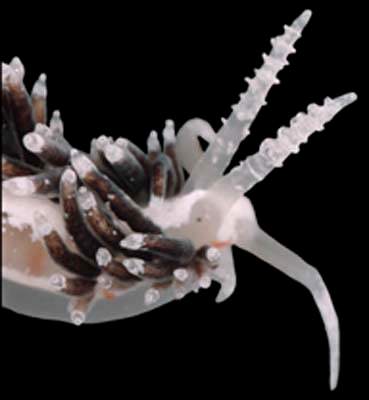Learchis poica from the Bahamas
September 24, 2002
From: Colin Redfern

Dear Bill,
In response to your request for photos of Learchis poica, here are three from Abaco, Bahamas. Marcus & Marcus (1960) described the rhinophores as perfoliate, but in Abaco they are mostly annulate. However, the annulations are often irregular or incomplete, as observed by Edmunds (1964) on animals from Jamaica.
The three photographed animals are all from Abaco, Bahamas, at a depth of about 1m:
Upper Right: 8mm. On Sargassum on shoreline rocks, Cooperstown. July 18, 1998.
Lower Left: 12mm. On hydroids on attached Sargassum at Pinder's Point. June 25, 1994.
lower Right: 14mm. On hydroids on attached Sargassum, Roberts' Boatyard. June 9, 1996.
References:
• Edmunds, M. 1964. Eolid Mollusca from Jamaica, with descriptions of two new genera and three new species. Bulletin of Marine Science of the Gulf and Caribbean, 14(1): 1-32.
• Marcus, Ev. & Er. Marcus. 1960. Opisthobranchs from American Atlantic warm waters. Bulletin of Marine Science of the Gulf and Caribbean, 10(2): 129-203.
• Redfern. C., 2001 Bahamian Seashells: a Thousand Species from Abaco, Bahamas.
Best wishes,
Colin
Bahamianseashells@att.net


Thanks Colin,
I am afraid words like 'perfoliate' and 'annulate' are not used very consistently in the literature. Also Marcus & Marcus were describing the anatomy of preserved specimens, and from their drawings the rhinophores are greatly contracted. The 'perfoliations' could easily just be wrinkles caused by the contraction. I also see the only information they give us of the living colour is 'the living slugs had paler or darker reddish brown diverticula of the digestive gland shining through the epidermis of the cerata, whose tips were white'. Fortunately Edmunds, in a number of publications, and Thompson, have given us quite a full account of this species and its variations.
Best wishes,
Bill Rudman
Related messages
-
Learchis poica colour forms
From: Alvin Alejandrino, February 26, 2007 -
Learchis poica from Southeast Florida
From: Linda Ianniello, February 13, 2004
